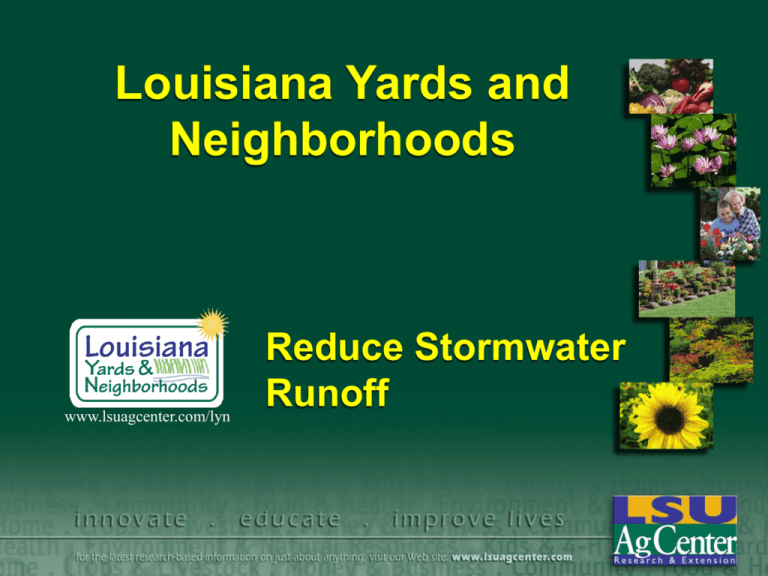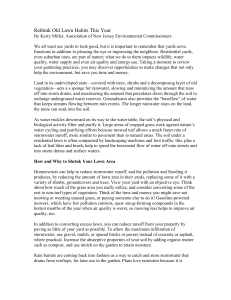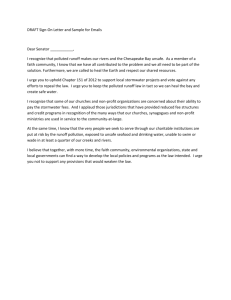Louisiana Yards and Neighborhoods Reduce
advertisement

Louisiana Yards and Neighborhoods www.lsuagcenter.com/lyn Reduce Stormwater Runoff Reduce Stormwater Runoff • Stormwater runoff – Definition – Problems – Solutions • Best Management Practices (BMPs) – Prevent runoff – Vegetative cover • Alternatives • Groundcovers – Reduce pollutants – Fertilizer – Pesticides Hydrologic Cycle • Water on earth is constantly recycled • Components of water cycle: – Soil Infiltration – Evaporation – Transpiration - the process by which plants release water into the atmosphere – Surface and channel storage – Groundwater storage The soil matrix filters and somewhat detoxifies impurities from water as it travels through the ground. Urbanization Intensity of land use Amount of impervious surfaces Water quality degradation Nonpoint source pollution Sources of pollution that cannot be pinpointed to any single cause. Usually associated with trash, car oil, chemical lawn products and other residues that are easily carried away by flowing water. Stormwater Runoff - Rainwater that flows off yards, roads and parking lots, carrying pollutants into our waterways. According to the EPA, polluted runoff is the #1 water quality issue in Louisiana Nutrients Toxins Sediments Thermal Stress Debris Pathogens Photo courtesy of NEMO Stormwater Contaminants Metals zinc, cadmium, copper, chromium, arsenic, lead Organic chemicals pesticides, oil, gasoline, grease Pathogen viruses, bacteria, protozoa Biochemical oxygen demand (BOD) grass clippings, fallen leaves, human and animal waste Sediment sand, silt and other particles Salts sodium chloride, calcium chloride Nutrients nitrogen, phosphorus The Problem • Increased volume of surface runoff • Increased velocity of surface runoff • Concentration of pollutants in runoff Elevated nutrients can cause: – Polluted drinking water – Excessive aquatic plant growth – Lower dissolved oxygen levels – Fish kills The Solution • Use practices or methods to prevent, reduce, retard or remove stormwater runoff contaminants before reaching receiving waters. • Best Management Practices (BMPs) are a series of direct recommendations based on research, evaluation and educated assumptions. Be Louisiana Friendly Regardless of the type of property you own, you can help preserve Louisiana’s natural resources by: 1) Preventing runoff 2) Increasing vegetative cover 3) Reducing pollutants Prevent Runoff Keep rain and irrigation water on your property and out of storm drains. Factors Affecting Stormwater Runoff: • • • • • • Rainfall intensity, flow rate, season % impervious surfaces Watershed size, slope Soil type, soil compaction Type of vegetation Density of vegetation Within our control Not within our control Minimize Runoff by Using Pervious Surfaces… for walkways, patios and driveways Direct Downspouts and Gutters Toward Porous Areas If downspouts drain to planted areas, be sure to select plants adapted to periodic flooding. Collect Rain Water Use a rain barrel or a cistern to collect and store runoff for irrigation purposes. Cistern Plan Irrigation Schedules According to the Weather • Water during early morning hours. – Plants are already wet. – Less evaporation losses. • Water less frequently in cooler months. • Water “as needed,” not routinely. • Do not irrigate if rain is expected. Earth Shaping If your property is sloped, you may want to make minor grade changes to divert runoff. This can be accomplished with terraces. Terracing can be an attractive design element in your yard. Berms and Swales Creating swales (low areas) and berms (raised earthen areas) will help to catch, hold and filter storm water. Elevations and depressions as small as 3-6 inches can make a huge difference. Vegetative Cover Planting groundcovers on slopes is an excellent way to: • Catch and filter storm water. • Slow the velocity of water movement. • Reduce erosion. Turf grass is a versatile groundcover that is effective at filtering nutrients. Covering the Ground With a Carpet of Vegetation Has Other Advantages • Attractive • Insulates the soil • Acts as a living mulch that helps build up humus levels in the soil • Provides habitat and cover for beneficial insects and other predators Blanketflower Gaillardia pulchella Disadvantages • If the ground cover is too vigorous, it may require containment. • It can compete with other plants for water and nutrients. Sweet potato Ipomea batatas ‘Margarita’ The following factors should also be taken into account, when choosing the right plant for the right place… Select Plants Based on Site Conditions • • • • • • • Acid, alkaline - (test your soil’s pH) Dry, moist Full sun, shade Heat, cold Salt Space Obstructions Periwinkle Catharanthus roseus ‘Diva’ Alternative Groundcovers For Shaded Areas Lilyturf Liriope muscari (USDA Zone 6-11) Periwinkle Vinca major (USDA Zone 8-11) Cast Iron Plant Aspidistra elatior (USDA Zone 8-11) Alternative Groundcovers Beach Sunflower Helianthus debilis (USDA Zone 8B-11) Perennial Peanut Arachis glabrata (USDA Zone 8-11) Clover Trifolium repens (USDA Zone 5-11) Alternative Groundcovers For Sunny Areas Asiatic Jasmine (USDA Zone 8-11) Trachelospermum asiaticum Junipers (USDA Zone 8-11) Juniperus spp. Tree Canopy Incorporate trees in the landscape – Intercept rainfall – Reduce soil compaction, thus improving water infiltration into soil – Increase the property value – Energy efficient way to cool the home Reduce Pollutants Because water can wash off our yards, it is important to reduce the amount of pollutants on our property. • Sweep grass and soil back onto lawns. • Sweep up any fertilizer on impervious surfaces. • Remove trash. • Clean up oil spills and leaks with cat litter. • Pick up after pets. It is unrealistic, even unwise, to strive for an insect, disease and weed-free yard. Instead: • Learn to identify key pests associated with the plants in your yard. • Check plants regularly for signs of pest problems. • Determine what amount of damage warrants action. Manage Yard Pests Responsibly • Avoid routine applications of pesticides. • Choose the least harmful method of control. • Treat only affected area rather than spraying the entire yard. Fertilize Appropriately If applied improperly, excess fertilizers can run off our yards into waterways or leach into groundwater. • Follow printed instructions carefully! • Do not apply fertilizer or pesticides before a heavy rainstorm. Louisiana Yards and Neighborhoods www.lsuagcenter.com/lyn Reduce Stormwater Runoff








